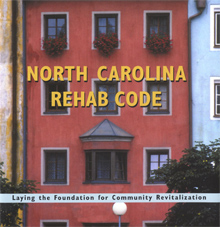Building Codes & Accessibility
It can be difficult to abide by building codes without compromising the integrity of a historic structure. While safety and accessibility are extremely important issues for architecture today, they were not always considered in the construction of our historic buildi ngs. Consequently, many historic structures must be updated to align with codes and regulations, which can be a daunting task.
ngs. Consequently, many historic structures must be updated to align with codes and regulations, which can be a daunting task.
The North Carolina Rehab Code is the first building code in North Carolina written specifically for existing buildings; moving away from the dependence on new buildings as the correct measuring safety guide.
The code makes is easier and less expensive to rehabilitate existing buildings. In addition, it encourages the upgrade of buildings and supports affordable housing efforts. Furthermore, the code gives more freedom in rehabbing historic buildings.
Except when otherwise specified, this code manages all building matters concerning repair, renovation, alteration, reconstruction, change of use, and additions.
When using this code, the 2002 North Carolina State Building Code does not apply. Only when the building has never been occupied or is significantly demolished is the 2002 North Carolina State Building Code relevant.
See Section 1.33 of the Rehab Code for specific guidelines addressing historic buildings.
The NC State Historic Preservation Office has additional information on Historic Structures and the State Building Code.
Visit the Mecklenburg County website for application forms as well as additional information regarding the review process for projects using the NC Rehab Code.
Further writings on building codes and historic rehabilitation:
Breaking the Codes: How State and Local Governments are Reforming Building Codes to Encourage Rehabilitation of Existing Structures (January 2006). By Philip Mattera, Good Jobs First
Building Codes and Historic Rehabilitation Conference: Synopsis and Reflections (June 2008). By Caroline Alderson and Marilyn Kaplan, AIA
Americans with Disabilities Act (ADA)
In 1990 Congress passed the Americans with Disabilities Act (ADA), a comprehensive civil rights law that concentrates on the needs of people with disabilities. It banned discrimination in employment, public services, public accommodations, and telecommunications. The law expanded the range of existing accessibility laws to cover nearly all public properties; thus requiring all new and existing public buildings to meet accessibility requirements for individuals with impaired mobility, hearing, speech, and sight disabilities.
The ADA can pose a threat to destroy historically significant details of a public building; consequently, the ADA allows for alternative solutions for compliance (see section 4.1.7). These exceptions are only applicable for a building or facility that is designated as historic under State or local law; or is listed in or eligible for listing on the National Register of Historic Places.
When working with public, historic properties make sure to comply with the following:
- Include at least one accessible route into the building.
- Include at least one accessible toilet when toilet facilities are provided.
- Include access to all public areas on the main floor.
- Include accessible displays and written information.
- Follow all ADA regulations when possible.
For more information:
Making Historic Properties Accessible by Thomas C. Jester and Sharon C. Park, AIA (National Park Service)

